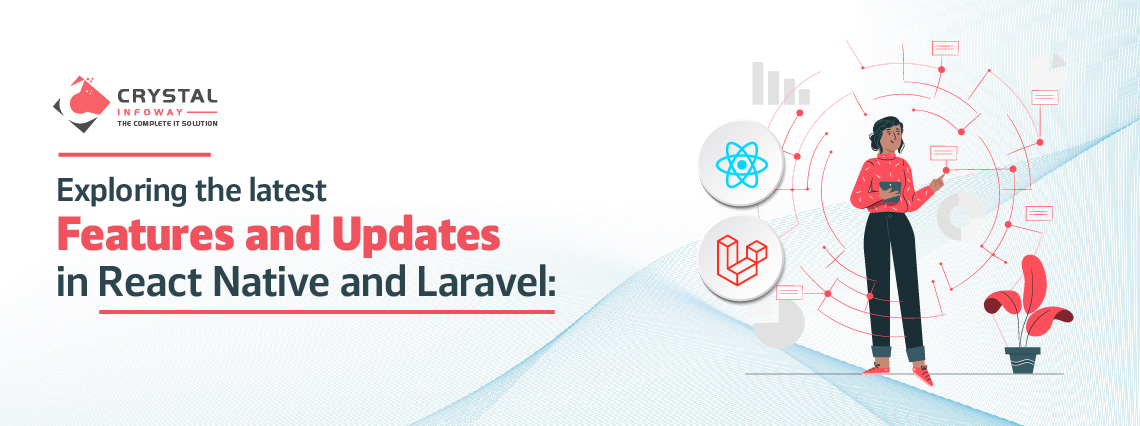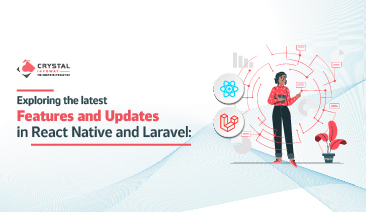Crystal Infoway
Exploring the latest Features and Updates in React Native and Laravel
Introduction
React Native and Laravel are two popular technologies used for building mobile and web applications, respectively. They are constantly evolving, and with each new release, they bring exciting new features and updates that enhance the development experience and enable developers to build more powerful and efficient applications. This blog will explore the latest features and updates in React Native and Laravel.
Exploring the Latest Features in React Native
React Native is a widely used framework for building cross-platform mobile applications using React, a JavaScript library for building user interfaces. With regular updates and improvements, React Native continues to evolve, providing developers with new tools and features that enhance the development process. Let's explore some of the latest features in React Native:
- Hermes Engine: Hermes is a JavaScript engine optimized for running on mobile devices, and it has been integrated into React Native as the default JavaScript engine for Android applications. Hermes provides faster startup times, smaller app sizes, and improved overall performance, making React Native applications more efficient and responsive on Android devices.
- Flipper Integration: Flipper is a powerful debugging tool for mobile applications developed by Facebook, and it has been integrated into React Native as a plugin. Flipper allows developers to inspect and debug their React Native applications visually and intuitively, providing insights into the UI components, network requests, and state management, among other features. This makes debugging React Native applications easier and more efficient.
- Improved Accessibility: Accessibility is an important aspect of mobile app development, and React Native has introduced several improvements to make apps more accessible. React Native now supports accessibility features such as voiceover, screen readers, and dynamic text sizing, making it easier to build apps that are accessible to users with disabilities.
- New Navigation System: React Native has introduced a new navigation system called "React Navigation" which provides a more flexible and customizable way to handle navigation in mobile apps. With React Navigation, developers can create complex navigation flows, handle deep linking, and customize the look and feel of the navigation bar, among other features. This makes it easier to build navigation-heavy applications with React Native.
- Fast Refresh: Fast Refresh is a hot-reloading feature in React Native that allows developers to see the changes they make in the code without having to manually reload the app. Fast Refresh provides a more seamless development experience, allowing developers to iterate quickly and see the results of their changes in real time.
- Concurrent Mode: Concurrent Mode is a new feature in React Native that allows applications to be more responsive and handle complex UI interactions more efficiently. Concurrent Mode enables concurrent rendering, which allows the app to respond to user input and run background tasks without blocking the main thread, resulting in a smoother and more responsive user experience.
- Codegen: Codegen is a feature in React Native that provides static typing for the props of components, making it easier to catch errors and ensure type safety in your application. Codegen generates TypeScript definitions for your components based on their prop types, providing better code completion and error detection in IDEs.
Exploring the Latest Updates in Laravel
Laravel is a popular PHP framework known for its elegant syntax, robust features, and a large community of developers. It constantly evolves with regular updates, bringing new features, improvements, and bug fixes to enhance the development experience and enable developers to build modern web applications. Let's explore some of the typical areas of updates in Laravel:
- Improved Performance: Laravel has always been focused on performance optimization, and with each new update, there are often improvements to make applications faster and more efficient. This could include updates to the query builder, caching system, and other performance-related features, resulting in faster response times and better overall performance for Laravel applications.
- New Features and Enhancements: Laravel updates often bring new features and enhancements to the framework, allowing developers to build more powerful and feature-rich applications. This could include updates to authentication and authorization, routing, middleware, event handling, and other core features of the framework. Laravel's development team actively listens to feedback from the community, and new features are often added based on the needs and requests of the developers.
- Security Enhancements: Security is a top priority for Laravel, and updates often include improvements to address potential security vulnerabilities. This could include updates to the authentication system, CSRF protection, input validation, and other security-related features to ensure that Laravel applications are secure and protected against common web vulnerabilities.
- Code Organization and Architecture: Laravel follows the MVC (Model-View-Controller) architectural pattern, and updates often bring improvements to the code organization and architecture of Laravel applications. This could include updates to the routing system, middleware handling, and other aspects of the application's structure, making it easier for developers to organize their code and build scalable and maintainable applications.
- Developer Experience (DX): Laravel is known for its developer-friendly syntax and tools, and updates often focus on improving the developer experience (DX). This could include updates to the documentation, debugging tools, error handling, and other features that make it easier for developers to build, debug, and maintain Laravel applications.
- Ecosystem Updates: Laravel has a vibrant ecosystem of packages and extensions, and updates to the framework often bring updates to these packages as well. This could include updates to popular Laravel packages such as Eloquent, Blade, and Horizon, among others, providing new features, improvements, and bug fixes to the Laravel ecosystem.
- Community Contributions: Laravel has a large and active community of developers who actively contribute to the framework's development. Updates often include bug fixes, performance improvements, and new features contributed by the community, making Laravel a truly community-driven framework.
In conclusion, Laravel is a constantly evolving framework with regular updates that bring new features, improvements, and bug fixes to enhance the development experience and enable developers to build modern web applications. However, based on Laravel's history and trends, you can expect performance improvements, new features and enhancements, security enhancements, code organization and architecture, developer experience (DX), ecosystem updates, and community contributions in future updates of Laravel.






